Okay. This Is What Happened. This Is Canon, There Have Been Unreliable Narrators Before And No One Can
Okay. This is what happened. This is canon, there have been unreliable narrators before and no one can prove me wrong. Tolkien estate can eat my entire ass.
Legolas and Gimli are living life in middle earth until Gimil is ready to pass on and Legolas starts building a boat.
This is the first time the redneck backwoods prince has ever had to fabricate something. He's never crafted a functional object in his entire life and Gimli, from an entire race of fanatical craftsman, watches his elf get into a leaky bathtub and nearly drown in 3 feet of water. In a pond.
Gimli goes, yeah, okay, I guess I can take up another hobby and becomes the first, last, and only dwarven shipwright ever. The boat he makes is the world's first, last, and only Ironside, and it looks like a seige engine. Legolas helps and stands around looking pretty and does a lot of explaining when they show up in Valinor to dock with all the pretty elven sloops in the Khazad-dûm II.
More Posts from Erdesse and Others
Here it is folks:
My definitive ranking of my least favorite bodies of water! These are ranked from least to most scary (1/10 is okay, 10/10 gives me nightmares). I’m sorry this post is long, I have a lot of thoughts and feelings about this.
The Great Blue Hole, Belize
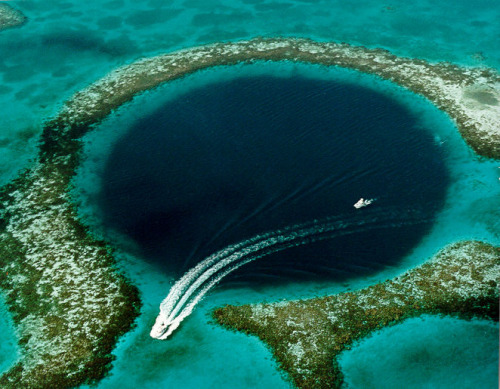
I’ve been here! I have snorkeled over this thing! It is terrifying! The water around the hole is so shallow you can’t even swim over the coral without bumping it, and then there’s a little slope down, and then it just fucking drops off into the abyss! When you’re over the hole the water temperature drops like 10 degrees and it’s midnight blue even when you’re right by the surface. Anyway. The Great Blue Hole is a massive underwater cave, and its roughly 410 feet deep. Overall, it’s a relatively safe area to swim. It’s a popular tourist attraction and recreational divers can even go down and explore some of the caves. People do die at the Blue Hole, but it is generally from a lack of diving experience rather than anything sinister going on down in the depths. My rating for this one is 1/10 because I’ve been here and although it’s kinda freaky it’s really not that bad.
Lake Baikal, Russia
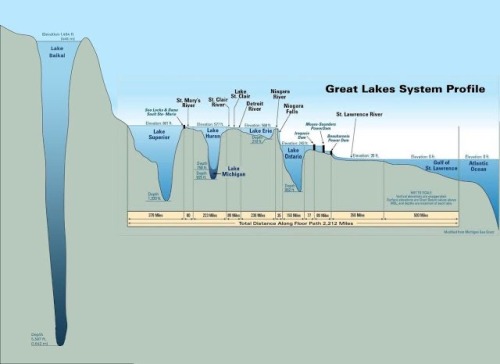
When I want to give myself a scare I look at the depth diagram of this lake. It’s so deep because it’s not a regular lake, it’s a Rift Valley, A massive crack in the earth’s crust where the continental plates are pulling apart. It’s over 5,000 feet deep and contains one-fifth of all freshwater on Earth. Luckily, its not any more deadly than a normal lake. It just happens to be very, very, freakishly deep. My rating for this lake is a 2/10 because I really hate looking at the depth charts but just looking at the lake itself isn’t that scary.
Jacob’s Well, Texas

This “well” is actually the opening to an underwater cave system. It’s roughly 120 feet deep, surrounded by very shallow water. This area is safe to swim in, but diving into the well can be deadly. The cave system below has false exits and narrow passages, resulting in multiple divers getting trapped and dying. My rating is a 3/10, because although I hate seeing that drop into the abyss it’s a pretty safe place to swim as long as you don’t go down into the cave (which I sure as shit won’t).
The Devil’s Kettle, Minnesota
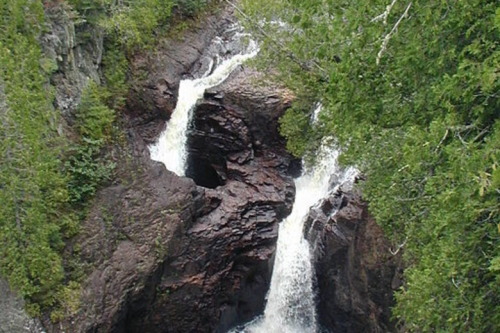
This is an area in the Brule River where half the river just disappears. It literally falls into a hole and is never seen again. Scientists have dropped in dye, ping pong balls, and other things to try and figure out where it goes, and the things they drop in never resurface. Rating is 4/10 because Sometimes I worry I’m going to fall into it.
Flathead Lake, Montana
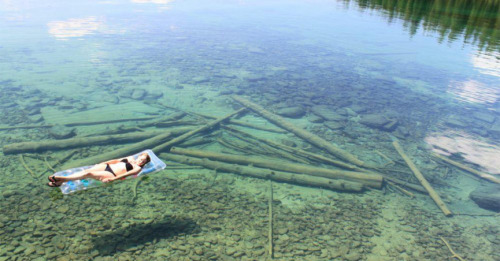
Everyone has probably seen this picture accompanied by a description about how this lake is actually hundreds of feet deep but just looks shallow because the water is so clear. If that were the case, this would definitely rank higher, but that claim is mostly bull. Look at the shadow of the raft. If it were hundreds of feet deep, the shadow would look like a tiny speck. Flathead lake does get very deep, but the spot the picture was taken in is fairly shallow. You can’t see the bottom in the deep parts. However, having freakishly clear water means you can see exactly where the sandy bottom drops off into blackness, so this still ranks a 5/10.
The Lower Congo River, multiple countries
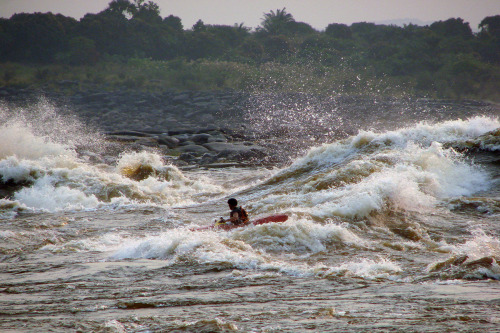
Most of the Congo is a pretty normal, if large, River. In the lower section of it, however, lurks a disturbing surprise: massive underwater canyons that plunge down to 720 feet. The fish that live down there resemble cave fish, having no color, no eyes, and special sensory organs to find their way in the dark. These canyons are so sheer that they create massive rapids, wild currents and vortexes that can very easily kill you if you fall in. A solid 6/10, would not go there.
Little Crater Lake, Oregon
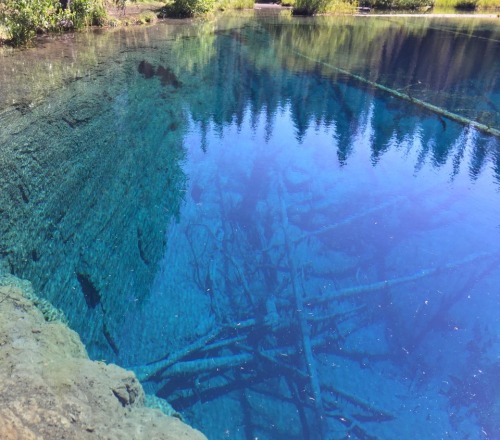
On first glance this lake doesn’t look too scary. It ranks this high because I really don’t like the sheer drop off and how clear it is (because it shows you exactly how deep it goes). This lake is about 100 feet across and 45 feet deep, and I strongly feel that this is too deep for such a small lake. Also, the water is freezing, and if you fall into the lake your muscles will seize up and you’ll sink and drown. I don’t like that either. 7/10.
Grand Turk 7,000 ft drop off
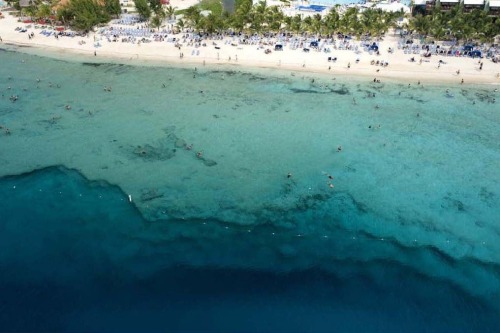
No. 8/10. I hate it.
Gulf of Corryvreckan, Scotland
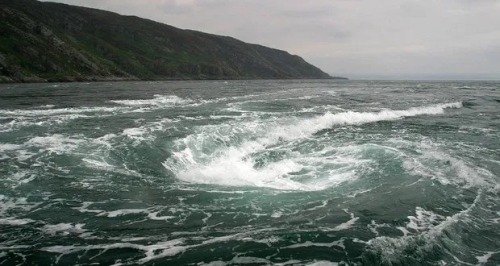
Due to a quirk in the sea floor, there is a permanent whirlpool here. This isn’t one of those things that looks scary but actually won’t hurt you, either. It absolutely will suck you down if you get too close. Scientists threw a mannequin with a depth gauge into it and when it was recovered the gauge showed it went down to over 600 feet. If you fall into this whirlpool you will die. 9/10 because this seems like something that should only be in movies.
The Bolton Strid, England
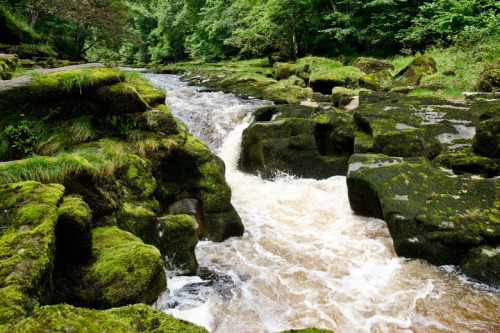
This looks like an adorable little creek in the English countryside but it’s not. Its really not. Statistically speaking, this is the most deadly body of water in the world. It has a 100% mortality rate. There is no recorded case of anyone falling into this river and coming out alive. This is because, a little ways upstream, this isn’t a cute little creek. It’s the River Wharfe, a river approximately 30 feet wide. This river is forced through a tiny crack in the earth, essentially turning it on its side. Now, instead of being 30 feet wide and 6 feet deep, it’s 6 feet wide and 30 feet deep (estimated, because no one actually knows how deep the Strid is). The currents are deadly fast. The banks are extremely undercut and the river has created caves, tunnels and holes for things (like bodies) to get trapped in. The innocent appearance of the Strid makes this place a death trap, because people assume it’s only knee-deep and step in to never be seen again. I hate this river. I have nightmares about it. I will never go to England just because I don’t want to be in the same country as this people-swallowing stream. 10/10, I live in constant fear of this place.
Honorable mention: The Quarry, Pennsylvania
I don’t know if that’s it’s actual name. This lake gets an honorable mention not because it’s particularly deep or dangerous, but it’s where I almost drowned during a scuba diving accident.
Actually I think having kids is too normalized.
I mean like; not only has it become an expectation for people (not just talking about fascists and sexist pigs controlling women's choices) but people are just so... Out of touch with what "having a baby" actually means.
Not just for the immediate future but also long term.
"We'll cross that bridge if it comes to it!" is an alarmingly common response these days when parents are questioned about the future with their child. People seem to be so caught up in just having a child and a pretty nursery that they don't seem to think beyond that point at all.
I know so, so many people who suffered a shitty upbringing because their parents had a child because "its just what couples do." Parents who never planned for unforeseen circumstances. Parents who left crucial developmental stages to other people. Parents who never bothered to learn how to actually raise another human being.
Well lads, I decided to make a fourth water ranking list! Some of these were suggested or requested, in which case I’ll @ them, and others were just some that I’ve read about since my last post and wanted to talk about! Enjoy.
Zambezi River, Africa, @marshmallowmachinegun

This river is making the list primarily because of the massive, terrifying rapids that you can apparently surf on. I don’t care for that shit at all. It earns the first spot on this list for being super freaky, 1/10.
Lake Toplitz, Austria, @darthlenaplant

This is, strangely, a lake with two bottoms. Around 52 feet down is a bunch of sunken logs, essentially creating a false bottom that divers can’t get through. Below this level, there is no oxygen in the lake and life becomes very scarce. But the lake has a maximum depth of 328 feet, and allegedly contains boxes of Nazi gold somewhere in the deeps. This draws in treasure-hunters, but I definitely won’t be heading down into this false-bottomed lake anytime soon. Since this lake doesn’t have any visible drop-offs or looks particularly scary, it gets a 2/10.
Dean’s blue hole, Bahamas

Until the discovery of the Dragon Hole in China, Dean’s blue hole was considered the deepest “blue hole” in the world, reaching a maximum depth of 663 feet. One of the reasons this underwater cave is so unsettling to me is it’s proximity to land. Like, can you imagine walking along a beach and looking out at the ocean and seeing that just a few hundred feet away?? For being such a visually dramatic hole in the ground, it earns a 3/10.
Cetina River, Croatia, @imalwayssirius

Often referred to as the “natural Eye of Sauron” (or, as I saw one of my mutuals post, the earth’s vagina) this bizarre feature is the source of the Cetina River. The spring bubbles up from a cave that reaches depths of over 300 feet and drains into a river 63 miles long. Although this spring is definitely beautiful, I don’t know that I would want to raft over it. 4/10.
Red lake, Croatia

The Red Lake sits in a deep sinkhole, with cliffs soaring over 800 feet above the water. Below the surface, the sinkhole continues for another 942 feet. The depth was unknown until 2017, when a diver finally descended far enough to see the bottom. The incredible depth of this lake makes it one of the largest sinkholes in the world, and earns it a 5/10 on this list.
Lake Peigneur, Louisiana, @amzrigh

I don’t know where to start with this one. I guess we have to go back to 1980, when this was a 10-foot deep freshwater lake. Underneath the lake was a massive salt mine, and on the surface was an oil drill. Basically, a miscalculation occurred and the drill broke down into the mines and this lake began to drain into them. Unfortunately, this lake wasn’t closed off, and used to empty into a nearby bay. As the lake drained down into the mines, the water flow reversed and sucked water in from the bay, briefly creating a 100+ foot waterfall and then the largest man made whirlpool in history. Although multiple ships from the bay were sucked down and the mines were completely flooded, amazingly no one was killed in this horrifying accident. So, what was once a 10-foot deep freshwater lake is now a 200-foot deep saltwater lake. The bizarre story and extreme depth of this lake gets a solid 6/10.
Kern River, California, anon

There are signs around this river which state “Kern River, 271 lives lost since 1968”. That would be enough to scare me off, but apparently not everyone feels the same. This river is so deadly because in many places, it appears calm and inviting, drawing in swimmers, and then sucking them under with a fast undertow. In fact, you are required to wear a life jacket if you’re even walking around the river with no intentions to swim (although it doesn’t appear that the person in this picture heeded those warnings). For sheer danger, I have to award this a 7/10.
Barracuda lake, Philippines, @pineowlple

Don’t worry, the lady in the picture is fine, she was just posing for a creepy photo. And this lake is fascinating for reasons other than its sheer drop and weird rock formations! Barracuda Lake has one of the most bizarre thermoclines and haloclines in the world, drawing in divers from far and wide who want a unique experience. The surface of the lake is freshwater and roughly 82 degrees F, but as you descend to about 50 feet down, the temperature in the lake suddenly rises to 100 F (only slightly cooler than an average hot tub)! This is because the lake contains both fresh and saltwater, separated by a hazy boundary. If you continue heading down to the bottom, the water will become cool again. Divers often describe swimming in this lake as a strange sensory experience, with some people claiming you feel weightless and liken it to being on another planet. Even stranger, the sandy lake bottom is described as being “jelly-like”. Definitely an 8/10 for how downright strange this lake is.
Enchanted river, Philippines

This river is a popular tourist destination for its beautiful blue waters and fascinating history. Some local legends report seeing fish down in the depths that cannot be caught by any line or net, and claim that the river’s color came from fairies. The mysteries of this river continue in modern day, as no one has been able to find the source of it. Exploration of the enchanted river started in 1999, and a hidden cave was soon discovered 98 feet down. During the sixth exploration of the cave, a diver died after reaching 130 feet deep. So far, divers have descended 269 feet into the cave, and mapping efforts are underway, but the bottom has yet to be found. 9/10 for the strange legends and seemingly being bottomless.
La Fosse Dione, France

This beautiful karst spring has a name which literally translates to “Divine Pit”. The spring has been used for water since Roman Times, but despite its long history it is shrouded in mystery. The strangest part of this pit is that no one knows where the water comes from. Roughly 82 gallons of water enters this spring every second, but the source is unknown. Several divers have descended into the depths of this pit, and none have been able to locate the bottom. In 1974, two divers went down and never resurfaced. In 1996, another diver attempted to find the source and died as well. In 2019, yet another diver went down and reached 1,213 feet before having to resurface. He did not find the bottom either. 10/10 to this lovely, French bottomless pit.
Bottomless Pits
We post holes here, sir.
Sinkholes, pit caves, wells and cenotes all have one thing in common; sometimes they’re bottomless. Not truly “bottomless”, of course, but in appearance, reputation, or of incredible depth. We’ve seen a few of these “bottomless pits” in prior lists such as the Lost Sea in Tennessee or the Devil’s Hole in Nevada, but today we will focus on those strange places in the earth that seem to be endless.
1. Laguna Kaan Luum, Mexico

This one threw me for a loop because I was originally only seeing pictures like the one above, so I was like ‘oh, that’s cool, so it’s kinda like Dean’s Blue Hole, where it’s an ocean sinkhole right off the shore…’
No. It’s not that. Let’s zoom out a bit.
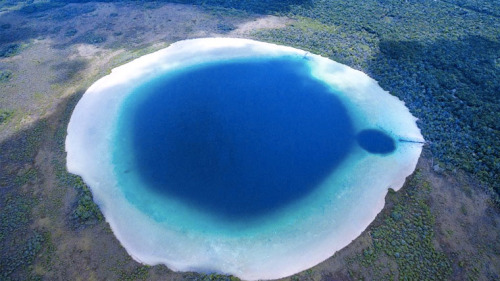
Yeah. This is a lake with one giant sinkhole in the middle! It’s about 2,000 feet across and reaches depths of 278 feet, with the surrounding shallows a very pleasant 4 feet deep! I’m mostly including it on the list because the full image hit me like a bus.
2. Sima Humboldt, Venezuela

Tepuis are large plateau mountains found across Venezuela, often with sheer sides and inaccessible tops that inspired explorers to imagine dinosaurs still surviving on these isolated mesas. Even on their own, tepuis are incredible, beautiful and mysterious. Add a sinkhole with an even more isolated forest at the bottom, and you have all the ingredients for some crazy shit to happen. Sima Humboldt and Sima Martel are two enormous sinkholes at the top of Cerro Sarisariñama. Humboldt is the largest at over a thousand feet across and nearly the same in depth, with a jungle flourishing at the bottom. The sinkhole forests are home to many endemic species of both plant and animals, but so far, no prehistoric monsters have been found in any of them.
3. Well of Barhout, Yemen

The “well of hell” is a massive sinkhole in the desert, measuring about 100 feet in diameter and plunging down over 300 feet. Understandably, there are many myths and legends about this place, including a story about an evil djinn which lives at the bottom and takes the head of anyone foolish enough to climb in. In fact, so pervasive are these legends that the sinkhole was only formally explored in 2021! Luckily they did not find any evil spirits, but they did find stalagmites which reached 30 feet tall, cave pearls, and waterfalls which provided refuge for frogs and snakes.
4. Myakka sinkhole, Florida

This murky abyss is filled with more than just water, it is also home to over a hundred alligators. Due to the poor visibility and very high concentration of large carnivores, it is very difficult to study this pit. Only a few people have ever glimpsed the bottom of this 134-foot deep sinkhole, but apparently we aren’t missing much because the water down there is stagnant and inhospitable to most life. Exactly why this area is so popular among alligators is still unknown, but it’s likely due to a combination of food availability and ideal temperatures.
5. The Pit cenote, Mexico

Like Cenote Angelita, The Pit is a layered cenote. The first 88 feet is freshwater, then there is a “fog” of hydrogen sulfide, below which lies over 300 feet of brackish water. The Pit is a spectacular-looking cenote, with an almost otherworldly quality, which makes it very popular among divers. So far, this pit has been explored to a depth of 390 feet, but unexplored passages extend further.
6. Thor’s well, Oregon

Like a drainpipe continuously swallowing an unbroken stream of ocean water, Thor’s well is often likened to a bottomless pit. However, it is actually only about 20 feet deep, and the drain effect is due to the fact that it connects back to the ocean, not swallowing the water but simply rerouting it. This does not mean that there is no danger, though. The rocks are slippery and sharp, and this area sees a higher than average number of ‘sneaker waves’; waves that look normal as they roll in but are actually much larger than they appear, potentially sweeping people out to sea as they retreat. The true danger here is the ocean, not the well.
7. Vouliagmeni Lake, Greece
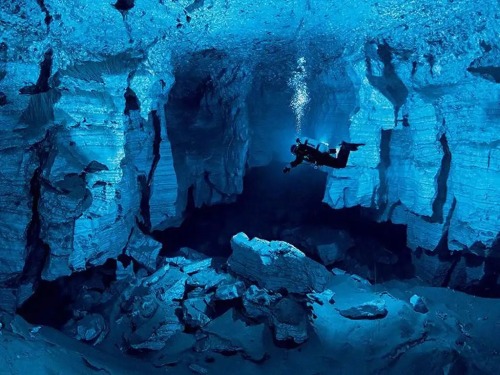
This incredibly beautiful saltwater lake has been rumored to have healing properties for thousands of years, and today continues to draw in visitors for its medicinal minerals and “doctor fish”. But this famous lake hides a secret; a labyrinth of caves whose depths have never been fully explored, and whose connection to the ocean remains undiscovered. Passages stretch over a mile into the mountains, with an average depth of 260 feet. The largest of these caverns is nearly 500 feet wide and full of warm sea water. Although a spectacular diving spot, these unknown caverns are best not underestimated.
8. Santa Rosa blue hole, New Mexico

A gorgeous natural swimming hole, this cenote is roughly 80 feet wide and 80 feet deep (in most places) and is a popular destination for tourists. It was also used for diving certification tests, until an incident in 1976. There is one spot in this picturesque cenote that goes down much further than 80 feet; the entrance to a cave. In the dark, twisting passages, two young divers got lost and died, and the cave was later sealed with a metal grate to prevent other divers from attempting to enter. The cave was mostly forgotten about until 2013, when cave divers were given permission to attempt to map the area. The blue hole is at least 200 feet deep, but the bottom of the cave still has not been found.
9. Roaring River Spring, Missouri
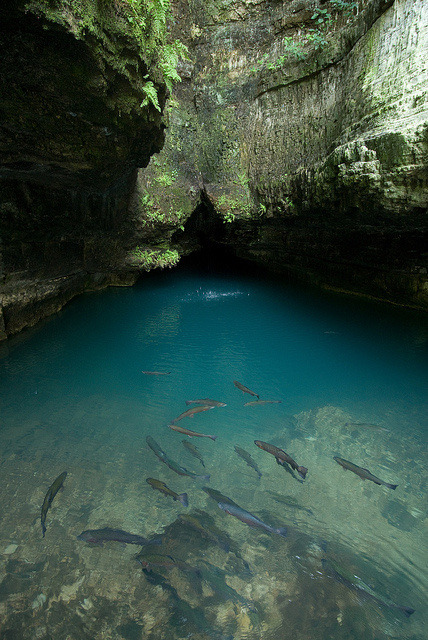
This turquoise river bubbles up from a ten-foot wide pool of deep water hidden within a sheer-sided canyon. But despite its peaceful appearance, this spring discharges 20 million gallons of water a day, and the exact source is still unknown. In 1979, divers attempted to map the cave, but reached a point 225 feet down where the passage constricted and had a water flow like “the force of an open fire hydrant”, preventing them from going any further. In 2020, divers waited until the water flow was lowest in the summer and descended to a depth of 472 feet with no bottom in sight, making this the deepest spring in the US!
10. Your Mom.
I jest, of course. Here’s the real one:
Hranice Abyss, Czech Republic

A tiny greenish lake in the forest is the opening to the deepest freshwater cave in the world, deeper than the Empire State Building is high and still seemingly bottomless. It is so deep that scientists think it may have been formed by a totally different process than most freshwater caves; instead of water eroding away the ground from above, it may have been created by acidic groundwater coming up from below. And this water is extremely acidic, able to burn a diver’s skin if not covered properly. This, combined with fallen trees and other debris, poor visibility, and the sheer vertical drop of the cave, creates incredibly dangerous conditions for diving. Because of this, no diver or ROV has reached the bottom yet. But with a recent study using seismic sensors, scientists have estimated that the abyss may be over a kilometer deep, twice what was previously thought.
-
 this-is-filler reblogged this · 2 months ago
this-is-filler reblogged this · 2 months ago -
 this-is-filler reblogged this · 4 months ago
this-is-filler reblogged this · 4 months ago -
 blackheartedmadera liked this · 11 months ago
blackheartedmadera liked this · 11 months ago -
 envylimes reblogged this · 1 year ago
envylimes reblogged this · 1 year ago -
 dreamingofcreation liked this · 1 year ago
dreamingofcreation liked this · 1 year ago -
 distinguishedmugstudentpersona liked this · 2 years ago
distinguishedmugstudentpersona liked this · 2 years ago -
 aureentuluva70 liked this · 2 years ago
aureentuluva70 liked this · 2 years ago -
 taroschain reblogged this · 2 years ago
taroschain reblogged this · 2 years ago -
 taroschain liked this · 2 years ago
taroschain liked this · 2 years ago -
 timetravelingsherlockian liked this · 2 years ago
timetravelingsherlockian liked this · 2 years ago -
 betweenbutterflies reblogged this · 2 years ago
betweenbutterflies reblogged this · 2 years ago -
 niaswish reblogged this · 2 years ago
niaswish reblogged this · 2 years ago -
 niaswish liked this · 2 years ago
niaswish liked this · 2 years ago -
 whimsicalmadness2013 liked this · 2 years ago
whimsicalmadness2013 liked this · 2 years ago -
 hyperlexia-1 reblogged this · 2 years ago
hyperlexia-1 reblogged this · 2 years ago -
 eldal0te liked this · 2 years ago
eldal0te liked this · 2 years ago -
 da3antra liked this · 2 years ago
da3antra liked this · 2 years ago -
 erdesse reblogged this · 2 years ago
erdesse reblogged this · 2 years ago -
 erdesse liked this · 2 years ago
erdesse liked this · 2 years ago -
 cheese-flavored-adhd liked this · 2 years ago
cheese-flavored-adhd liked this · 2 years ago -
 poppy3019 liked this · 2 years ago
poppy3019 liked this · 2 years ago -
 puppybearuniverse liked this · 2 years ago
puppybearuniverse liked this · 2 years ago -
 toxic-luck liked this · 2 years ago
toxic-luck liked this · 2 years ago -
 aceduchessdragoness reblogged this · 2 years ago
aceduchessdragoness reblogged this · 2 years ago -
 leanagar liked this · 2 years ago
leanagar liked this · 2 years ago -
 lovelylilbadone liked this · 2 years ago
lovelylilbadone liked this · 2 years ago -
 reallyreallywannasleep liked this · 2 years ago
reallyreallywannasleep liked this · 2 years ago -
 get-more-bald liked this · 2 years ago
get-more-bald liked this · 2 years ago -
 q1ieg98n liked this · 2 years ago
q1ieg98n liked this · 2 years ago -
 myriadofstuff liked this · 2 years ago
myriadofstuff liked this · 2 years ago -
 skywewe liked this · 2 years ago
skywewe liked this · 2 years ago -
 foulzinedreamflap liked this · 2 years ago
foulzinedreamflap liked this · 2 years ago -
 fishless-fish liked this · 2 years ago
fishless-fish liked this · 2 years ago -
 ark-bile liked this · 2 years ago
ark-bile liked this · 2 years ago -
 fluidnet reblogged this · 2 years ago
fluidnet reblogged this · 2 years ago -
 haladim reblogged this · 2 years ago
haladim reblogged this · 2 years ago -
 haladim liked this · 2 years ago
haladim liked this · 2 years ago -
 ringoftheanscestors reblogged this · 2 years ago
ringoftheanscestors reblogged this · 2 years ago -
 happilymassivehypocrite reblogged this · 2 years ago
happilymassivehypocrite reblogged this · 2 years ago -
 happilymassivehypocrite liked this · 2 years ago
happilymassivehypocrite liked this · 2 years ago -
 legallynotgreen reblogged this · 2 years ago
legallynotgreen reblogged this · 2 years ago -
 legallynotgreen liked this · 2 years ago
legallynotgreen liked this · 2 years ago -
 theeclectickoalastudent reblogged this · 2 years ago
theeclectickoalastudent reblogged this · 2 years ago -
 theeclectickoalastudent liked this · 2 years ago
theeclectickoalastudent liked this · 2 years ago -
 franzwantscoffee reblogged this · 2 years ago
franzwantscoffee reblogged this · 2 years ago -
 franzwantscoffee liked this · 2 years ago
franzwantscoffee liked this · 2 years ago -
 angelictroublemaker liked this · 2 years ago
angelictroublemaker liked this · 2 years ago -
 thetragicallynerdy liked this · 2 years ago
thetragicallynerdy liked this · 2 years ago -
 the-unicorns-of-nienna reblogged this · 2 years ago
the-unicorns-of-nienna reblogged this · 2 years ago







